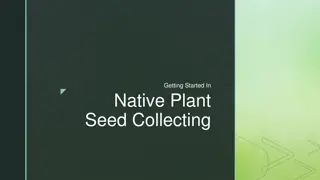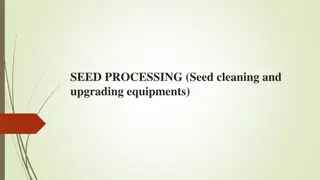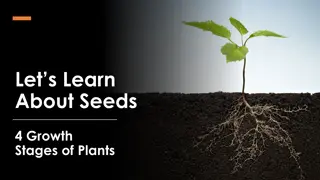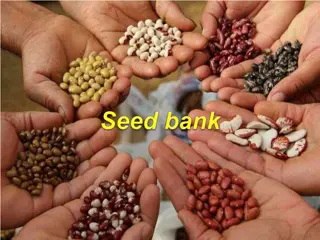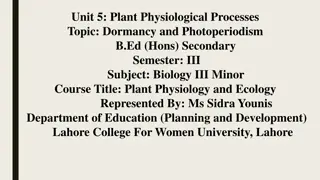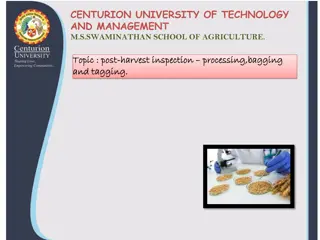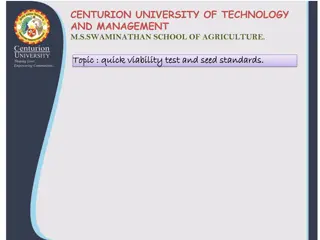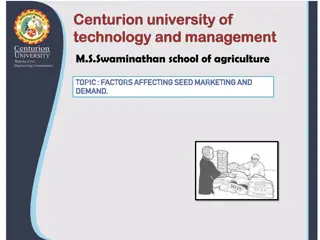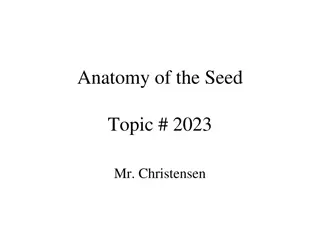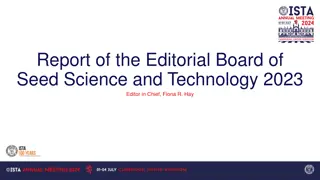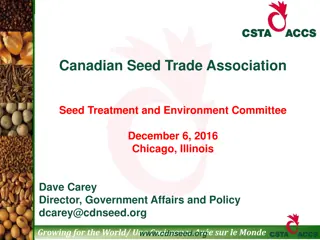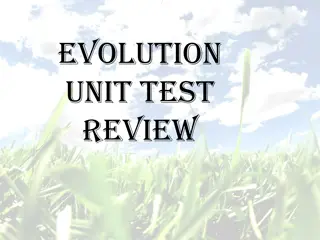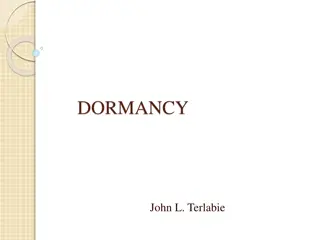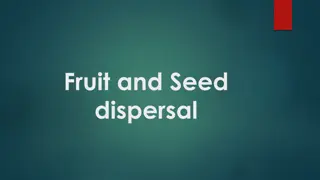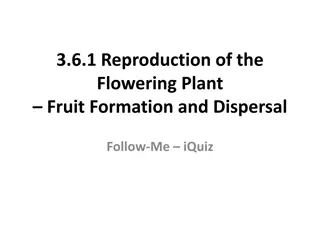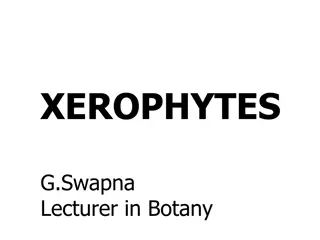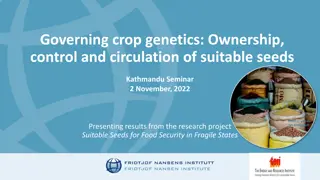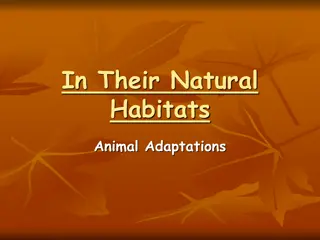Exploring Seed Plant Diversity and Adaptations
Delve into the realm of seed plants, uncovering their unique adaptations for reproduction, their phylogeny with gymnosperms and angiosperms, and the diversity within gymnosperms such as conifers, cycads, gingkophytes, and gnetophytes. Discover the evolutionary success of seed plants through their water-independent reproduction, dominant sporophyte phase, and the development of seeds and pollen. Explore the fascinating life cycle of a conifer and the various adaptations that have allowed seed plants to thrive on Earth.
Download Presentation

Please find below an Image/Link to download the presentation.
The content on the website is provided AS IS for your information and personal use only. It may not be sold, licensed, or shared on other websites without obtaining consent from the author. Download presentation by click this link. If you encounter any issues during the download, it is possible that the publisher has removed the file from their server.
E N D
Presentation Transcript
SEED PLANTS Chapter 26
Seed Plant Adaptations Reproduction is not water-dependent Sporophyte phase is dominant Heterosporous Megaspores (female, produce egg) and microspores (male, produce sperm) Seeds Female gametophyte: produces haploid egg and provides protection, nourishment to embryo Pollen Male gametophyte: produces and protects haploid sperm These adaptations allowed seed plants to be most successful plants on Earth
Seed Plant Phylogeny Gymnosperms and Angiosperms are sister taxa Gymnosperms ( naked seed ) appeared 390 mya Conifers, Cyads, Gingkophytes, Gnetophytes Angiosperms ( seed in a vessel ) appeared 200 mya All flowering plants Fertilization and embryo development occur inside plant ovary (fruit) Mutualistic relationships with pollinators Mutualistic relationships with animals as seed distributors
Gymnosperms Naked seeds Sheltered by woody leaves called sporophylls Male and female gametes on separate organs (cones) If male and female cones are on same plant, then it is Monoecious ( one home ): male and female cones on same plant Dioecious ( two homes ): male cones on one plant, female cones on separate plant Pollination by wind Tracheids Perforated, lignified cells that transport water/minerals Dominant xylem cell in gymnosperms Adapted to live without water for part of the year Can live in cold, dry regions Conifers, Cycads, Gingkophytes, Gnetophytes
Gymnosperm Diversity Conifers Dominant phylum of gymnosperms Reduce leaf shaped like needle Adapted to cold, dry weather Live at high altitudes Cycads Dominant during prehistoric times Mistaken for palms (Sago palm) Live in mild climates Gingkophytes Only one surviving species, Gingko biloba Fan-shaped leaf Gnetophytes Unresolved phylogeny Inhabit arid desert regions around the world
Life Cycle of a Conifer The tree is the sporophyte (2n) Heterosporous microsporangia produce male microspores megasporangia produce female megaspores Microsporangia are located on small male pollen cones Megasporangiaare located on large female ovulate cones Microsporocytes are diploid (2n) cells within the microsporangium Produce haploid microspores via meiosis These give rise to the male gametophyte, also called pollen Pollen grains have two haploid cells surrounded by sporopollenin Generative cell and pollen tube cell Megasporocytesare diploid (2n) cells within the megasporangium Produce 4 haploid cells via meiosis Only one survives to become the megaspore which becomes the female gametophyte
Conifer Fertilization When the pollen grain lands at the base of the female scale, one haploid cell germinates towards the female gametophyte via the micropyle, creating a pollen tube As the pollen tube grows, the generative cell in the pollen produces two haploid sperm via mitosis One of the haploid sperm will fuse with the haploid egg The diploid egg, now an embryo, will divide via mitosis to become the seed It is enclosed in a seed coat from sporophyte tissue The seed contains three generations of tissue: Seed coat from the sporophyte Nutritive tissue from the gametophyte Embryo tissue (the new sporophyte) This process takes up to two years!
Angiosperms Dominant terrestrial plant group Two novel adaptations: Flowers Ensures pollination and protects embryo (seed) Fruit Embryo (seed) protection and dispersal Can be monoecious or dioecious Pollination by wind, insects, mammals Vessel cells in xylem tissue More efficient than tracheidsat conducting water
Angiosperm Flowers Modified leaves organized around a central receptacle Sepals, petals, carpels, and stamen Sepals are photosynthetic (often green) Petals display variety of colors to attract pollinators Carpel is called gynoecium, female sex organ Stigma, style, ovary Stamen is called androecium, male sex organ Anther, filament Perfect flower have carpels and stamen Monoecious Imperfect flowers have carpels OR stamen Dioecious
Gynoecium The gynoecium is the innermost part of the flower where the egg will form carpel Plants can one or more carpels Each carpel consists of a stigma, style, and ovary Stigma is where pollen is deposited Sticky surface to trap pollen Style is the tube through which the pollen tube will grow The ovary contains one or more ovules Megasporangia Each will eventually develop into a seed
Androecium The androecium are the stamen that surround the carpel Stamen consist of filament and a anther The filament is the thin stalk that supports the anther The anther is sac-like structure where microsporangia are located They will produce microspores which will develop into pollen grains
Life Cycle of an Angiosperm: Pollen production The tree is the sporophyte (2n) Heterosporousso microsporangia produce male microspores and megasporangia produce female megaspores Microsporangia are located in the anthers Microsporocytes are 2n cells within the microsporangium Produce haploid microspores via meiosis These give rise to the male gametophyte, also called pollen Pollen grains have 2 haploid cells surrounded by sporopollenin 1 cell becomes the pollen tube cell 1 cell divides via mitosis to form two haploid sperm
Life Cycle of an Angiosperm: Egg production The tree is the sporophyte (2n) Heterosporous so microsporangia produce male microspores and megasporangia produce female megaspores Megasporangia are located in the ovule Megasporocytesare 2n cells within the megasporangium Produce 4 haploid megaspores via meiosis Only the largest one survives to become the female gametophyte It divides three times via mitosis to produce eight nuclei distributed among seven cells Three cells are located at each pole of the embryo sac (this accounts for 6 of the 7 cells) Three cells at one pole become the egg and 2 synergids(helper cells) Three cells at the other pole become antipodal cells The center cell contains two nuclei (polar nuclei), will become endosperm So, the mature embryo sac contains: 1 egg, 2 synergids, 3 antipodal cells that degenerate and a central cell with 2 nuclei
Life Cycle of an Angiosperm: Double Fertilization When pollen attaches to the stigma, the pollen tube cell germinates from the pollen grain down through the style, and enters the ovule through the micropyle Two sperm are deposited in the embryo sac Double fertilization occurs 1 sperm and the egg fuse to form the diploid zygote (embryo seed) 1 sperm fuses with the polar nuclei cell to form a triploid cell that will become the endosperm Nutritive tissue for the embryo
Life Cycle of an Angiosperm: The seed The embryo seed develops to form a radicle (root) and either one or two leaf-like structures called cotyledons The difference in the number of cotyledons is what separates the angiosperms into two groups: Monocots (one cotyledon) Eudicots (two cotyledons) The seed itself has a tough outer layer called the seed coat, the endosperm food reserves for the embryo, and the embryo.
Life Cycle of an Angiosperm: The fruit The walls of the ovary thicken to form the fruit The seed is inside the ovary (fruit) Fleshy fruits are berries, apples, tomatoes, eggplant, etc. Dry fruits are grains such as rice, wheat, and nuts Fruits are adaptations for seed dispersal Wind carries small, light fruit (dandelions) Water carries floating fruits (coconuts, mangrove seeds) Fruits with burrs get stuck on animal fur and are transported over distance Fruits as food, animals eat the fruits, poop out the seeds
Diversity of Angiosperms One phylum, Anthophyta Three major groups: Basal angiosperms (not going to cover these) Monocots Eudicots Monocots and Eudicots have differences in; Number of cotyledons Type of flowers Leaf venation Type of roots Location of vascular bundles Vascular bundle: transport tissue structure with both xylem and phloem conductive tissue are present Type of structural tissue
Monocots One cotyledon First leaf in seedling Flower parts are in symmetry of 3 or 6 3 petals, 3 sepals 6 petals, 6 sepals Leaf venation is parallel along the length of the leaf Multiple, fibrous roots Vascular bundles are scattered in stem and are organized in a ring in root No true woody tissue Woody tissue is secondary xylem monocots do not have secondary xylem Grasses, palms, rice, corn, banana, etc.
Eudicots Two cotyledons First leaves in seedling Flower parts are in symmetry of 4 or 5 4 petals, 4 sepals 5 petals, 5 sepals Or combination of 4, 5 Leaf venation is networked One main tap root with smaller fibrous roots attached Vascular bundles are organized in a ring in stem and root Can have woody tissue Woody tissue is secondary xylem eudicots can have secondary xylem (wood) Two-thirds of all angiosperms are eudicots Apples, beans, oaks, roses, etc.
Angiosperms and Coevolution Current hypotheses suggest that angiosperms and insects have evolved together over time Herbivory of plants by insects and animals has contributed to coevolution Examples of coevolution of herbivores and plant defenses strategies: An evolutionary arms race Unpalatable or toxic (animal taste buds change or they develop mechanisms to mitigate the toxin) Thorns and spines (animals develop thick fur or long beaks) Bark (animals develop strong teeth and jaws) Plants also exploit animals! Dispersal of seeds by herbivores plants have evolved sweeter, juicier fruit to entice animals) Pollination of plants by insects and other animals has also contributed to coevolution 80% of angiosperms depend on animals for pollination Plants have evolved strategies for attracting animals to their flowers Nectar and associated flower color Fertile pollen and sterile pollen These complex interactions have increased diversity in both plants and insects/animals
Seed Plants and Humans 100% of human diet is dependent upon seed plants But, just a few staple crops are responsible for feeding the masses Mostly cereal crops high in carbohydrates Rice, wheat, corn, potatoes Beans, nuts, seeds provide protein and fats Fruits and vegetables provide complex carbohydrates, vitamins, minerals, fiber Leaves, flowers, and bark are dried and used in teas Animals raised for human consumption eat plants Wood provides structure and fuel and paper Plant fibers are woven into cloth Humans have used plants for medicinal purposes since for millennia
Plant Biodiversity Provides for humans Balances ecosystems Protects and cleans water systems Moderates climate Provides shelter/food for animals Plants and plant biodiversity are under attack Human population keeps increasing Need housing more land developed Need food clearing wild lands to grow crops Need energy dams, increased drilling for oil, coal Deforestation for wood Plant extinction rate is high Earth is an intricate system of interactions and balances No plants = no animals = no humans



